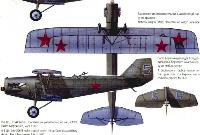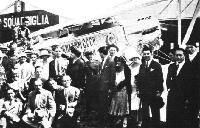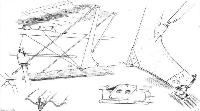
АНТ-3 (Р-3) и АНТ-10 (Р-7)
Прототип АНТ-3 выполнил первый полет в августе 1925 года, самолет предназначался, в первую очередь, для военного применения в качестве разведчика и обозначался Р-3. Это был неравнокрылый биплан цельнометаллической конструкции с гофрированной металлической обшивкой. После замены исходного мотора Liberty мощностью 400 л. с. (298 кВт) на двигатель Napier Lion мощностью 450 л. с. (336 кВт) самолет стал обозначаться Р-3НД.
На первых 12 серийных машинах стояли моторы Liberty, последующие 18 получили моторы М-5, которые представляли собой двигатель Liberty советского производства. На следующие 79 машин установили 450-сильные двигатели Lorraine Dietrich; самолеты обозначались Р-3ЛД. Испытывался один АНТ-3 с мотором BMW VI мощностью 680 л. с.
Максимальная скорость Р-3ЛД составляла 205 км/ч, вооружение - три 7,7-мм пулемета, на внешней подвеске самолет мог нести десять 10-кг бомб.
<...>
Описание:
- АНТ-3 (Р-3) и АНТ-10 (Р-7)
- Flight, November 1928
BERLIN AERO SHOW 1928
Фотографии
-
Мир Авиации 1994-02 / В.Котельников, В.Ригмант - Первый: история Р-3 /Авиадосье/
Р-3 ЛД (N 4085), 55 аэ, ЛВО, пилот Е.А.Разинко, март 1930г.
-
Мир Авиации 1994-02 / В.Котельников, В.Ригмант - Первый: история Р-3 /Авиадосье/
Р-3 ЛД (N 4114) с тропическим радиатором, "Комсомол Таджикистана", 35 оао, САВО, пилот В.Мареев, март 1932г.
-
Мир Авиации 1994-02 / В.Котельников, В.Ригмант - Первый: история Р-3 /Авиадосье/
Р-3 ЛД (N 4109) с тропическим радиатором, 37 аэ, САВО, пилот С.С.Стрельников, май 1930г.
-
АвиаМастер 2006-05 / В.Котельников - Красные звезды Туркестана /Из истории воздушных войн/ (2)
Разведчик Р-3, Среднеазиатский военный округ, 1931г.
-
Мир Авиации 1994-02 / В.Котельников, В.Ригмант - Первый: история Р-3 /Авиадосье/
Р-3 ЛД (N 4106/5) с тропическим радиатором, 40 оао, САВО, пилот Маруженко, март 1931г.
-
Авиация и Космонавтика 1997-10 / В.Ригмант - Под знаками "АНТ" и "ТУ" (1)
Регистрационный номер: RR-SOV [2] АНТ-3 "Пролетарий"
Civil-registered ANT-3 flown to several European cities in 1926. -
Авиация и Космонавтика 2006-03 / А.Лашков - Из истории собственных наименований воздушных судов России (2)
Регистрационный номер: RR-SOV [2] Самолет-разведчик Р-3 (АНТ-3) "Пролетарий". 1925г.
-
Flight 1926-10 / Flight
Showing the Red Flag by Air: Soviet Russia is making every effort not to lag behind in the world of aeronautics, and recently the Russian pilot, Capt. Gromov, accompanied by his mechanic, Radzevich, made a tour of Europe in a Russian-built biplane fitted with a Napier "Lion" engine. They left Moscow on August 31 and flew to Konigsberg, Berlin, Paris, Rome, Vienna, Prague, Warsaw, and back to Moscow (September 3.) Our picture shows the machine at Rome. The "Ant," as the machine is called, is of all-metal construction,and maintained an average speed of 115 m.p.h. over the 4,350 miles.
-
Flight 1928-11 / Flight
A Russian Mail 'Plane: The A.N.T.3 sesquiplane is of all-metal construction, and bears strong evidence of German (Junkers) influence with its corrugated Duralumin covering. The fuselage is of approximately triangular cross-section.
-
Мир Авиации 1994-02 / В.Котельников, В.Ригмант - Первый: история Р-3 /Авиадосье/
Р-3М5 опытный на испытаниях в НИИ ВВС.
-
Мир Авиации 1994-02 / В.Котельников, В.Ригмант - Первый: история Р-3 /Авиадосье/
Регистрационный номер: СССР-Л738 Р-3М5, переоборудованный под сотовые радиаторы. Эксплуатировался в гражданской авиации.
-
Авиация и Космонавтика 2021-01 / О.Растренин - "Линейный штурмовик" для последовательной операции /Архивы раскрывают тайны/
Разведчик Р-3 с М-5. На основе разведчика Р-3ЛД (модификация Р-3 под французский мотор Лоррен-Дитрих мощностью 450 л.с.) в конце 20-х годов пытались создать легкий бронированный штурмовик ШР-3
-
Мировая Авиация 246
Большинство Р-3 состояло на вооружении ВВС РККА, но часть самолетов под обозначением АНТ-3 использовалось для почтовых перевозок, выполнения связных и пропагандистских полетов.
-
АвиаМастер 2006-05 / В.Котельников - Красные звезды Туркестана /Из истории воздушных войн/ (2)
Ремонт Р-3ЛД в мастерских 37-го авиапарка в Ташкенте, 1932г. Слева - дополнительный выдвижной водорадиатор и стойка шасси Р-3
-
Мир Авиации 1994-02 / В.Котельников, В.Ригмант - Первый: история Р-3 /Авиадосье/
Ремонт в полевых условиях.
-
Aviation Historian 11 / V.Kotelnikov - "We have our very own Soviet engine..."
The M-5 engine was also fitted to the Tupolev R-3 reconnaissance biplane, built using the new Kolchug construction technique, similar to the corrugated structures used by Junkers. The R-1’s large drag-inducing radiator was replaced on the R-3 with a pair of Lamblin "lobster pot” radiators, one of which is clearly visible here.
-
АвиаМастер 2006-05 / В.Котельников - Красные звезды Туркестана /Из истории воздушных войн/ (2)
Аварийный посадки Р-3 в среднеазиатских барханах были не редкостью
-
Мир Авиации 1994-02 / В.Котельников, В.Ригмант - Первый: история Р-3 /Авиадосье/
Р-3ЛД N4106/5, 40 оао, 5 апреля 1931г., пилот Маруженко врезался в гору между Тамерлановыми Воротами и Китабом. Полет для установления связи с отрядом кзыл-аскеров.
-
Flight 1928-11 / Flight
RUSSIAN METAL CONSTRUCTION AT THE BERLIN SHOW: The mail 'plane A.N.T.3 was built entirely of Duralumin. The larger sketch shows the wing bracing, while insets illustrate details of the wing strut attachment with incidence adjustment, the step on the side of the fuselage, and the method of finishing off the trailing edge of the metal wing covering.
- Фотографии





















